What is Poetry?
¿Qué es poesía?, dices mientras clavas
en mi pupila tu pupila azul.
¿Que es poesía?, Y tú me lo preguntas?
Poesía... eres tú.
-original by Gustavo Adolfo Bécquer
What is poetry?, you ask
while your blue eyes rivet mine.
What is poetry? And you ask this?
Poetry... is you.
-translated by Howard A. Landman
What is poetry? thou say'st, and meanwhile fixest
On mine eye thine eye of deepest blue;
What is poetry? And canst thou ask it?
Why, - poetry - is - thou!
-Translated by Owen Innsly, Copyright ©1882 by A. Williams & Company
"What is poesy," you ask
While you fix your pupil blue
On my own. - An easy task
To reply; but why should you
Put this question unto me?
- You, yourself, are poesy.
-Translated by Jules Renard, Copyright ©1908 by Richard G. Badger
"What is poesy?" you ask me, gazing
Into mine eyes with your eyes blue.
What is poesy? And do you truly ask me?
Poesy . . . are you.
-Translated by Young Allison, Copyright ©1924 by Young Allison
"What is poetry?" you ask, as you hold
My eyes with your eyes of blue;
"What is poetry? Well, since you ask me,
It's you."
-Translated by Rupert Croft-Cooke, Copyright ©1927 by Rupert Croft-Cooke
What is poetry? you say,
Holding my eyes with yours of blue,
What is poetry? . . . You ask that?
Poetry . . . it is you!
-Translated by Ina D. Singleton, Copyright uncertain - from Poet Lore magazine circa 1939
Tuesday, July 19, 2005
Monday, July 18, 2005
Celebrations of the Devil
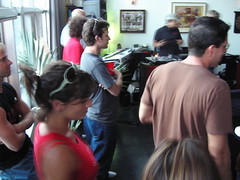
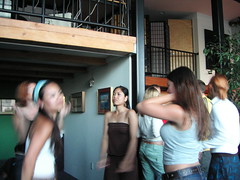
I have these cycles of sociability. I am capable of being extremely extroverted. But, a few months later I will tumble into an introverted state that is almost monastic in its extent.
I first met my friend A. during an extended social streak in high school. We have remained friends over the decades. He has never let go of this image of me, of this popular person, this charismatic being that he knew then. I think I was juggling several girlfriends at the time and first impressions are lasting.
A. lives in San Francisco now and every few months he holds private sessions at his loft with some of the most well-known DJs and musicians in the city. The guest list for these things is kept small. As he confided to me "This should be small enough to cultivate a sense of family but large enough to qualify as an event"
I sometimes make a showing at these things. I saw M. again who I have not seen in two years. She made me promise again that I would pick up my jazz piano again and her and I would play every hotel in town.
M. and her husband D., also an old friend of A's, are one of the few people I recognize. The guests at these events may be small but they are also always changing.
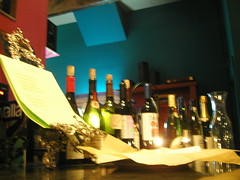
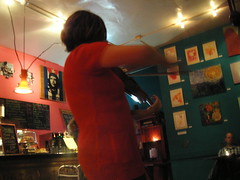
Afterwards, we wandered over to PapaTobys cafe on 22nd St where we got a private performamce. Talented singing girl with violin.
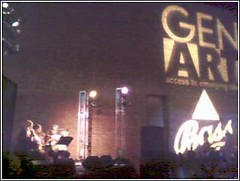
The night before, I was at the GenArts event which was fantastic. Firedancers, interactive art, large indoor and outdoor spaces, a number of smaller spaces where you could walk in and feel as if you have stumbled into something new. I showed someone some of my salsa moves. I was there with AH. We had walked into the event without paying ($35 I think) and right into the open bars.
I just told her "Lets walk forward confidently until someone stops us"
Nobody did.
----------
The week before, I attended an event (I was there with Bryan who was meeting all his fans) at which a woman whom I had never met came up to me and said this:
"You are the Devil."
When I tried to get her to explain, asking her what was it about me that had prompted that remark, she just looked at me suspiciously and added:
"You do like to talk about yourself, don't you?"


I have these cycles of sociability. I am capable of being extremely extroverted. But, a few months later I will tumble into an introverted state that is almost monastic in its extent.
I first met my friend A. during an extended social streak in high school. We have remained friends over the decades. He has never let go of this image of me, of this popular person, this charismatic being that he knew then. I think I was juggling several girlfriends at the time and first impressions are lasting.
A. lives in San Francisco now and every few months he holds private sessions at his loft with some of the most well-known DJs and musicians in the city. The guest list for these things is kept small. As he confided to me "This should be small enough to cultivate a sense of family but large enough to qualify as an event"
I sometimes make a showing at these things. I saw M. again who I have not seen in two years. She made me promise again that I would pick up my jazz piano again and her and I would play every hotel in town.
M. and her husband D., also an old friend of A's, are one of the few people I recognize. The guests at these events may be small but they are also always changing.


Afterwards, we wandered over to PapaTobys cafe on 22nd St where we got a private performamce. Talented singing girl with violin.

The night before, I was at the GenArts event which was fantastic. Firedancers, interactive art, large indoor and outdoor spaces, a number of smaller spaces where you could walk in and feel as if you have stumbled into something new. I showed someone some of my salsa moves. I was there with AH. We had walked into the event without paying ($35 I think) and right into the open bars.
I just told her "Lets walk forward confidently until someone stops us"
Nobody did.
----------
The week before, I attended an event (I was there with Bryan who was meeting all his fans) at which a woman whom I had never met came up to me and said this:
"You are the Devil."
When I tried to get her to explain, asking her what was it about me that had prompted that remark, she just looked at me suspiciously and added:
"You do like to talk about yourself, don't you?"
Saturday, July 16, 2005
Friday, July 15, 2005
From Ossian to Oscar Wilde
1762
James MacPherson discovers an ancient poem written in Gaelic.
The author is Ossian, son of Fingal.
1773
Thomas Jefferson establishes himself as a great fan of Ossian
1774
The Sorrows of Young Werther is published by Goethe, another fervent admirer of Ossian.
Within it, Werther exclaims:
Ossian has, in heart, supplanted Homer.
1796
Various editions of the Ossian poem are widely distributed and well received.
1813
Napoleon declares himself a huge fan of Ossian and commisions a painting by Ingres: The songs of Ossian
1844
Napoleon's godson becomes King Oscar I of Sweden.
Oscar was not a name in use at the time but had been imposed by Napoleon.
Oscar appears in Ossian.
1854
Named after King Oscar, Oscar Wilde is born
An excerpt from Ossian:
As the dark shades of autumn fly over the hills of grass; so gloomy, dark, successive came the chiefs of Lochlin's echoing woods. Tall as the stag of Morven, moved stately before them the king. His shining shield is on his side, like a flame on the heath at night; when the world is silent and dark, and the traveller sees some ghosts sporting in the beam! Dimly gleam the hills around, and show indistinctly their oaks! A blast from the troubled ocean removed the settled mist. The sons of Erin appear, like a ridge of rocks on the coast; when mariners, on shores unknown, are trembling at veering winds!
.
This is all well and good. It draws a literary line of influence through history. Napoleon held his dear book with him, printed up with old poems. The poems themselves however - were an invention.
1762
James MacPherson discovers an ancient poem written in Gaelic.
The author is Ossian, son of Fingal.
1773
Thomas Jefferson establishes himself as a great fan of Ossian
1774
The Sorrows of Young Werther is published by Goethe, another fervent admirer of Ossian.
Within it, Werther exclaims:
Ossian has, in heart, supplanted Homer.
1796
Various editions of the Ossian poem are widely distributed and well received.
1813
Napoleon declares himself a huge fan of Ossian and commisions a painting by Ingres: The songs of Ossian
1844
Napoleon's godson becomes King Oscar I of Sweden.
Oscar was not a name in use at the time but had been imposed by Napoleon.
Oscar appears in Ossian.
1854
Named after King Oscar, Oscar Wilde is born
An excerpt from Ossian:
As the dark shades of autumn fly over the hills of grass; so gloomy, dark, successive came the chiefs of Lochlin's echoing woods. Tall as the stag of Morven, moved stately before them the king. His shining shield is on his side, like a flame on the heath at night; when the world is silent and dark, and the traveller sees some ghosts sporting in the beam! Dimly gleam the hills around, and show indistinctly their oaks! A blast from the troubled ocean removed the settled mist. The sons of Erin appear, like a ridge of rocks on the coast; when mariners, on shores unknown, are trembling at veering winds!
.
This is all well and good. It draws a literary line of influence through history. Napoleon held his dear book with him, printed up with old poems. The poems themselves however - were an invention.
Sunday, July 10, 2005
The polymathic Piet Hein was an artist and mathematician. He invented the game of Hex, created a unique puzzle called the Soma cube and also is the father of an entirely new geometric entity - the SuperEllipse, as seen in Sergels Torg:
Man is the animal that draws lines which he himself then stumbles over. In the whole pattern of civilization there have been two tendencies, one toward straight lines and rectangular patterns and one toward circular lines. There are reasons, mechanical and psychological, for both tendencies. Things made with straight lines fit well together and save space. And we can move easily — physically or mentally — around things made with round lines. But we are in a straitjacket, having to accept one or the other, when often some intermediate form would be better. To draw something freehand — such as the patchwork traffic circle they tried in Stockholm — will not do. It isn't fixed, isn't definite like a circle or square. You don't know what it is. It isn't esthetically satisfying. The super-ellipse solved the problem. It is neither round nor rectangular, but in between. Yet it is fixed, it is definite — it has a unity.
—Piet Hein
But, Piet Hein for me and for many others is best loved and remembered as the father of grooks:
consolation grook
Losing one glove
is certainly painful,
but nothing
compared to the pain,
of losing one,
throwing away the other,
and finding
the first one again.
what love is like
Love is like
a pineapple,
sweet and
undefinable.
Grook to warn the universe against megalomania
The universe may be as great as they say.
But it wouldn't be missed if it didn't exist
A grook is a short aphorism and Hien wrote thousands of them. Each one is a short statement of truth or an admonition. And most were accompanied by a small drawing or cartoon. An encylopedia of abbreviated wisdom.
Man is the animal that draws lines which he himself then stumbles over. In the whole pattern of civilization there have been two tendencies, one toward straight lines and rectangular patterns and one toward circular lines. There are reasons, mechanical and psychological, for both tendencies. Things made with straight lines fit well together and save space. And we can move easily — physically or mentally — around things made with round lines. But we are in a straitjacket, having to accept one or the other, when often some intermediate form would be better. To draw something freehand — such as the patchwork traffic circle they tried in Stockholm — will not do. It isn't fixed, isn't definite like a circle or square. You don't know what it is. It isn't esthetically satisfying. The super-ellipse solved the problem. It is neither round nor rectangular, but in between. Yet it is fixed, it is definite — it has a unity.
—Piet Hein
But, Piet Hein for me and for many others is best loved and remembered as the father of grooks:
consolation grook
Losing one glove
is certainly painful,
but nothing
compared to the pain,
of losing one,
throwing away the other,
and finding
the first one again.
what love is like
Love is like
a pineapple,
sweet and
undefinable.
Grook to warn the universe against megalomania
The universe may be as great as they say.
But it wouldn't be missed if it didn't exist
A grook is a short aphorism and Hien wrote thousands of them. Each one is a short statement of truth or an admonition. And most were accompanied by a small drawing or cartoon. An encylopedia of abbreviated wisdom.
Saturday, July 02, 2005
The City Unraveled
So, I was going by Philz coffee again. (I had written about his popularity with women.)
As I was getting my coffee this time, I noticed a small pile of handmade books titled 'Love Letter to San Francisco' by a certain Spiralgirl. I bought one, the next to last.
The small booklet is divided into two parts. The first half is a series of love letters to san francisco. For example:
"Everything is timed, to the second. And
when you are synchronized with her, time
gets wider. And when time is wide, there is
more of a chance for the people to come into
your life who you are meant to meet.
When time is narrow, we barely notice
what we are doing, we are just going
through the motions."
The city is depicted as a woman, a lover. In these series of short pieces, Spiralgirl reveals a city that can be at times elusive, at times warm, a capricious creature who taunts us with her ravishing architecture but betrays us with her frigid weather. A city full of faults "She's impossible (when it comes to parking)" but redeemed by her charm , her "creative fire."
The second half of this little book is a list of specific places that Spiralgirl has collected. We all have collected places like these, those of us who have made a home here. A small private treasury:
"If you were a film director looking for the perfect lounge for your two characters to have an affair, I'd take you here..."
And
"Expect to see older men wearing white aprons at these places..."
The associated blog for this book is here.
------
"This is the city and I am one of the citizens,
Whatever interests the rest interests me. . . ."
-Walt Whitman
How do you characterize an entire City?
In 1925, the artist Frans Masereel set out to do just that in a small novel called Die Stadt (The City)
It is a wordless novel. Through a series of images, Masereel presents us with a collection of glimpses into this vast accumulation that we call a City.
Start here and then click on the words "Die Stadt" on that page to get started.
So, I was going by Philz coffee again. (I had written about his popularity with women.)
As I was getting my coffee this time, I noticed a small pile of handmade books titled 'Love Letter to San Francisco' by a certain Spiralgirl. I bought one, the next to last.
The small booklet is divided into two parts. The first half is a series of love letters to san francisco. For example:
"Everything is timed, to the second. And
when you are synchronized with her, time
gets wider. And when time is wide, there is
more of a chance for the people to come into
your life who you are meant to meet.
When time is narrow, we barely notice
what we are doing, we are just going
through the motions."
The city is depicted as a woman, a lover. In these series of short pieces, Spiralgirl reveals a city that can be at times elusive, at times warm, a capricious creature who taunts us with her ravishing architecture but betrays us with her frigid weather. A city full of faults "She's impossible (when it comes to parking)" but redeemed by her charm , her "creative fire."
The second half of this little book is a list of specific places that Spiralgirl has collected. We all have collected places like these, those of us who have made a home here. A small private treasury:
"If you were a film director looking for the perfect lounge for your two characters to have an affair, I'd take you here..."
And
"Expect to see older men wearing white aprons at these places..."
The associated blog for this book is here.
------
"This is the city and I am one of the citizens,
Whatever interests the rest interests me. . . ."
-Walt Whitman
How do you characterize an entire City?
In 1925, the artist Frans Masereel set out to do just that in a small novel called Die Stadt (The City)
It is a wordless novel. Through a series of images, Masereel presents us with a collection of glimpses into this vast accumulation that we call a City.
Start here and then click on the words "Die Stadt" on that page to get started.
Subscribe to:
Posts (Atom)
